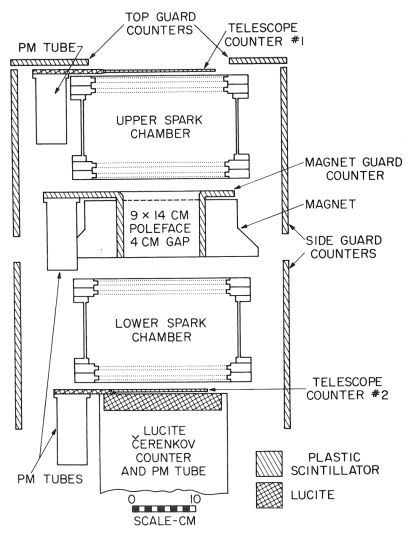Purpose of the flight and payload description
The objective of the POSITRON-NEGATRON (E±) EXPERIMENT was to measure the cosmic-ray positron and negatron spectra between 11 and 204 MeV using a Magnetic Spectrometer which measured the charge sign and magnetic rigidity (momentum divided by charge) of charged particles by determining their deflection in a magnetic field. The instrument was developed at the California Institute of Technology.
In the figure at left we can see a basic scheme of the detector used between 1968 and 1969 (click to enlarge). It consisted of a magnetic spectrometer utilizing a 1000-gauss permanent magnet, scintillation counters, and a lucite Cerenkov counter. A triple coincidence of Telescope Counter #1 (Tl), Telescope Counter #2 (T2), and the Lucite Cerenkov Counter (C), triggered the spark chamber high voltage and initiated the data readout cycle. Two 4-gap wire spark chambers determined the trajectory of the particle before and after traversal of the gap of a permanent magnet. The spark locations were detected by magnetostrictive pickups and recorded in digital form on magnetic tape.
The Lucite Cerenkov counter was designed to discriminate against upward-moving splash albedo particles and to eliminate the nucleonic component of the cosmic rays in the rigidity interval of interest. The specially designed Magnet Guard Counter covered the top of the magnet and completely lined the gap volume leaving a 3-cm x 12-cm open passage. That guard counter eliminated particles which might interact or scatter in the magnet pole pieces and, together with Tl and T2, defined the acceptance cone of the detector. Additional guard counters surrounded the sides of the instrument and covered the top with the exception of the telescope aperture. These counters eliminated charged particles which entered the detector from outside the acceptance cone and might subsequently interact, producing particles which triggered the telescope counters. All guard counters were in active anti-coincidence.
The atmospheric pressure during flight was monitored by a Wallace-Tiernan aneroid barometer which was photographed, together with a clock and a thermometer, at 5-minute intervals. An additional low-pressure gauge was read out electronically.
The entire instrument, with the exception of the barometer and 30 silver-zinc batteries, was enclosed in a pressure-tight aluminum gondola during flight. A 0.012-inch aluminum window allowed particles incident from above to penetrate the gondola with minimum scattering. The gondola was insulated and the temperature within was maintained above 45°F by thermostatically-controlled heaters. The weight of the instrument package was about 370 lbs.
Details of the balloon flight
Balloon launched on: 7/21/1968 at 1:04 utc
Launch site: Fort Churchill Airport, Manitoba, Canada
Balloon launched by: Raven Industries Inc.
Balloon manufacturer/size/composition: Zero Pressure Balloon
Flight identification number: 68C2
End of flight (L for landing time, W for last contact, otherwise termination time): 7/21/1968 at 19:18 utc
Balloon flight duration (F: time at float only, otherwise total flight time in d:days / h:hours or m:minutes - ): 18 h 15 m
External references
- A study of cosmic-ray positron and electron spectra in interplanetary and interstellar space and the solar modulation of cosmic rays Dissertation (Ph.D.) by Cummings, Alan Coffman, California Institute of Technology (1973)
- Cosmic ray negatron and positron spectra observed near Fort Churchill in 1968 at NASA technical reports server
- Cosmic-Ray Negatron and Positron Spectra Between 12 and 220 MeV Physical Review Letters, 22 (9). pp. 412 (1969)
- Primary Cosmic-Ray Positrons and Negatrons in 1968 at Energies Between 11 and 204 ME V. Thesis by Carl James Rice, California Institute of Technology, 1970
6026If you consider this website interesting or useful, you can help me to keep it up and running with a small donation to cover the operational costs. Just the equivalent of the price of a cup of coffee helps a lot.


